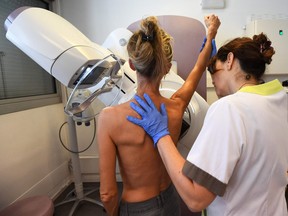Under-represented communities, in particular, need additional support — and it won’t cost much to make improvements.
Published Jan 27, 2024 • Last updated 1 day ago • 3 minute read
 In this file photo, a patient is pictured before mammography. Ontario recently lowered the age for regular breast screening to 40, rather than 50. Photo by ANNE-CHRISTINE POUJOULAT /AFP VIA GETTY IMAGES
In this file photo, a patient is pictured before mammography. Ontario recently lowered the age for regular breast screening to 40, rather than 50. Photo by ANNE-CHRISTINE POUJOULAT /AFP VIA GETTY IMAGES
I was happy to see that Ontario is taking action to address the need for revised breast cancer screening guidelines — but these revisions alone will not help thousands of breast cancer patients across Canada, particularly those suffering from more aggressive forms of the disease.
Ten to 20 per cent of the breast cancer population is diagnosed with triple negative breast cancer (TNBC), a more aggressive form of the illness that has fewer treatment options. This type of breast cancer impacts younger women, Black and Hispanic women disproportionately.
Advertisement 2
This advertisement has not loaded yet, but your article continues below.
THIS CONTENT IS RESERVED FOR SUBSCRIBERS ONLY
Subscribe now to read the latest news in your city and across Canada.
Exclusive articles from Elizabeth Payne, David Pugliese, Andrew Duffy, Bruce Deachman and others. Plus, food reviews and event listings in the weekly newsletter, Ottawa, Out of Office.Unlimited online access to Ottawa Citizen and 15 news sites with one account.Ottawa Citizen ePaper, an electronic replica of the print edition to view on any device, share and comment on.Daily puzzles, including the New York Times Crossword.Support local journalism.
SUBSCRIBE TO UNLOCK MORE ARTICLES
Subscribe now to read the latest news in your city and across Canada.
Exclusive articles from Elizabeth Payne, David Pugliese, Andrew Duffy, Bruce Deachman and others. Plus, food reviews and event listings in the weekly newsletter, Ottawa, Out of Office.Unlimited online access to Ottawa Citizen and 15 news sites with one account.Ottawa Citizen ePaper, an electronic replica of the print edition to view on any device, share and comment on.Daily puzzles, including the New York Times Crossword.Support local journalism.
REGISTER / SIGN IN TO UNLOCK MORE ARTICLES
Create an account or sign in to continue with your reading experience.
Access articles from across Canada with one account.Share your thoughts and join the conversation in the comments.Enjoy additional articles per month.Get email updates from your favourite authors.
Article content
Article content
Yet most people, including at the time of diagnosis, have never heard of TNBC; a lot of people don’t even know there are different types of breast cancer. We need to do a much better job of educating people. I know we’re asking a lot from the health-care system right now, but many of the steps to make life better for breast cancer patients aren’t costly or time-consuming.
Let’s start with the image we present of breast cancer. Think of the brochures and the faces featured: generally older women, usually white. Presenting a more inclusive image of breast cancer is an easy way to bring more comfort to the diverse women and men who are going through the difficulty of a breast cancer diagnosis.
Before diagnosis, we should be encouraging cancer prevention by widening genetic testing so those at risk of breast cancer are more vigilant. We know that anywhere between one in 20 or one in 10 breast cancer cases are hereditary. Mutations of the BRCA1 and BRCA2 genes are found to increase the risk of developing breast cancer from 45 to 85 per cent.
Improving availability to genetic testing and recommending it to those who have a family history of breast cancer could make it more likely to catch warning signs earlier. Early detection is crucial to effective treatment, especially when these genetic mutations carry a greater risk of TNBC. It is also important that other gaps to genetic testing, such as funding, are addressed.
Advertisement 3
This advertisement has not loaded yet, but your article continues below.
Article content
In addition to equipping patients with the right data, we have to ensure our health-care system is collecting the right information. Canada lags far behind places such as the United States when it comes to recording demographic patient data, particularly around race. Advocates have been calling on health-care providers to collect this data for years, hoping to address inequalities.
We saw the value of such data during the COVID-19 pandemic, where public health officials were able to see gaps in protection and promptly take action. Unfortunately, we haven’t learned from this and still fail to record this data when patients seek care, including breast cancer treatment. Asking these questions during intake or during treatment would be an easy and valuable step to making our health system more equitable.
Most importantly, at the heart of all our decision-making, we must also do a better job of supporting individuals who are diagnosed with TNBC. Again, this is usually women who are disproportionately younger at the time of diagnosis, with different obligations and responsibilities than those who are told they have breast cancer at an older age. Child care responsibilities, caring for parents, and professional and social circumstances are all impacted differently for this group.
Advertisement 4
This advertisement has not loaded yet, but your article continues below.
Article content
I understand the burdens of the medical system and the mass amounts of pressure provided by modernity; but we need to draw light to the fact that underrepresented women need our support. During the most frightening time of a woman’s life, the pillar she should feel the safest within should be the medical system. We are not asking for overnight change, we are asking to be met with an inclusive and gentle environment with patient support groups; to be supplied with proper education about the possible afflictions within our own bodies; and to be encouraged with quick and accessible genetic screening so that we know if and how we can be diligent. Many of these measures, including data collection, are not expensive — they just require changes.
As governments across Canada review screening guidelines, I encourage you to remain educated on the types and subtypes of breast cancer and to support those at risk and diagnosed with breast cancer in underrepresented or marginalized communities. There are a host of measures that can be taken. Let’s not lose this momentum and focus.
Quinn Obrigewitch, MSc., is a board member at the Canadian Breast Cancer Network. She has the BRCA1 mutation and a strong family history of triple negative breast cancer.
Recommended from Editorial

Pellerin: Give the Ottawa River legal ‘personhood’

Adam: ByWard Market is still the place to be, these business owners say
Article content
>>> Read full article>>>
Copyright for syndicated content belongs to the linked Source : OttawaCitizen – https://ottawacitizen.com/opinion/obrigewitch-even-more-must-be-done-to-tackle-breast-cancer































